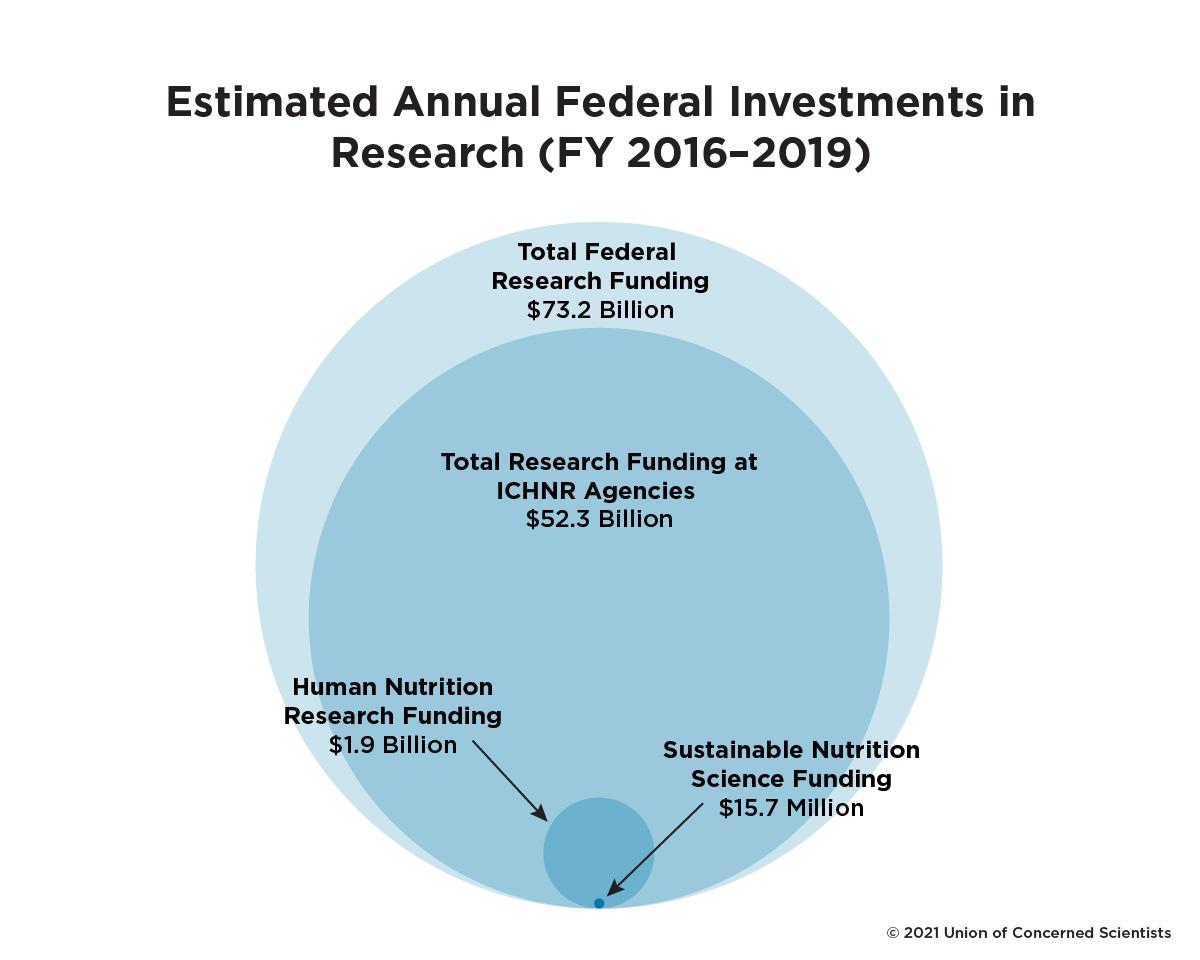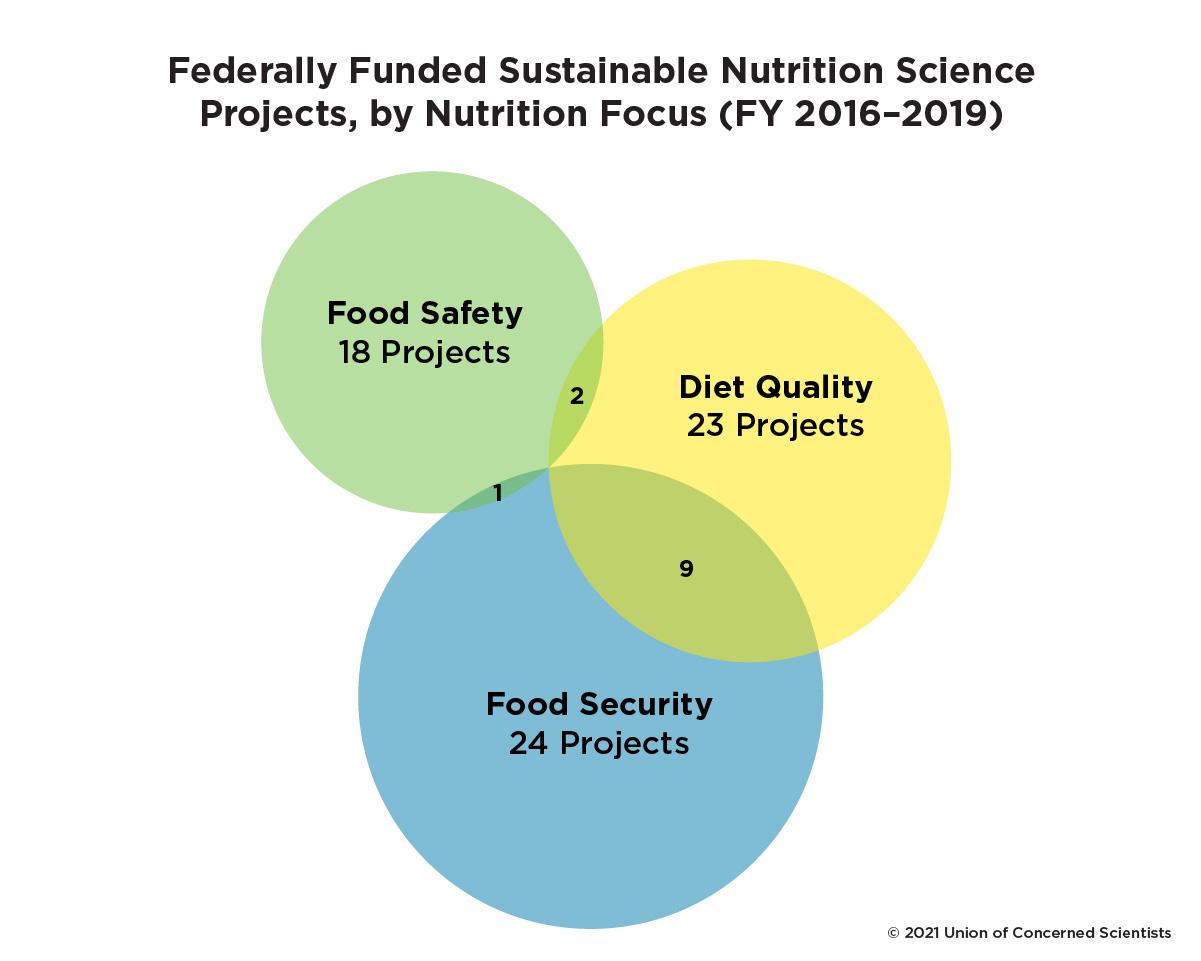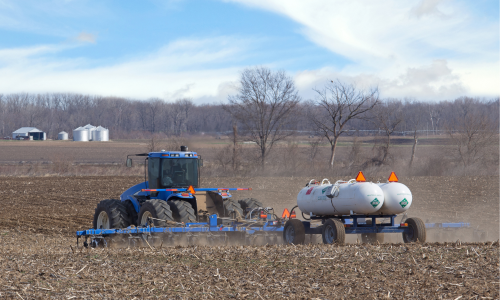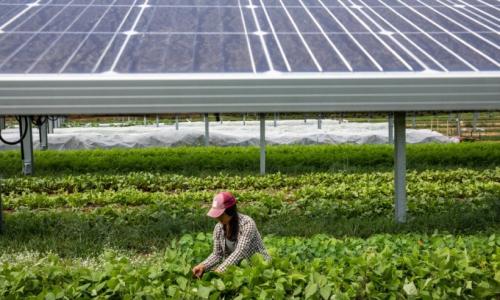Diet-related disease, climate change, and environmental degradation exact an enormous toll on human and planetary health. These challenges can be addressed in part by shifting what we eat and how we produce food, yet key questions remain about how to make such transitions effective, equitable, and sustainable.
To help answer these questions, investments in “sustainable nutrition science”—research and education at the intersection of food production, climate and environment, and nutrition—are urgently needed. However, the Union of Concerned Scientists has found that US public funding for sustainable nutrition science is severely limited, totaling an estimated $16 million annually between 2016 and 2019, and recommends more than tripling that amount in response to our devastating public health and environmental crises.
From Silos to Systems
Today, more people in the United States are sick than healthy, with many facing declining life expectancies (NCCDPP, n.d.; Foreman et al. 2018). Some of the most common chronic conditions, including cancer, cardiovascular disease, and type 2 diabetes, are directly linked to poor diets (Micha et al. 2017; Zhang et al. 2019). Such conditions also can increase the severity of viral infections and other illnesses, as demonstrated during the COVID-19 pandemic (Razzaghi et al. 2020). Meanwhile, how food is produced can contribute to climate change, air and water pollution, soil degradation, and biodiversity loss, all of which both pose additional severe health risks and threaten the availability of a healthy food supply (DeLonge and Stillerman 2020; Boehm 2020; FAO 2019). Further, racism and other intersecting forms of social and economic injustice perpetuate health disparities for many Black, Indigenous, and other people of color who are more likely to experience food insecurity, diet-related disease, and environmental exposures associated with food production (Castillo et al. 2021; Haynes-Maslow 2016; Odoms-Young and Bruce 2018; Shannon et al. 2015).
Developing food systems that are more healthful, sustainable, equitable, and resilient to increasingly extreme weather and other disruptions is essential, particularly in the face of climate change (Béné 2020; Harris and Spiegel 2019; Basche 2017; TEEB 2018; Spiker, Reinhardt, and Bruening 2020). However, the public health crises embedded in US food and farming systems are complex and span a wide range of disciplines and sectors. Developing lasting solutions requires systems thinking—a problem-solving approach that embraces complexity and focuses on the relationships among the parts of a system to identify structural challenges and the primary drivers of change (TEEB 2018; Tagtow, Herman, and Cunningham-Sabo 2021; DeLonge and Stillerman 2020; O’Rourke, DeLonge, and Salvador 2017). Solutions also require multiple disciplinary approaches drawing on the expertise of diverse stakeholders, including the people most affected by the negative consequences of food systems (Choi and Pak 2006).
Producing the necessary changes within food systems requires strong public investments in science and improved coordination across federal agencies. Indeed, for at least a decade, federal and scientific committees, reports, and workshops have repeatedly called for such multidisciplinary systems research, yet many key research questions remain (Miles, DeLonge, and Carlisle 2017; Myers et al. 2013; Fleischhacker et al. 2017; DeLonge 2015). Below is a list of the federal reports that have issued recommendations to advance research and education at the intersection of food production, climate and environment, and nutrition; see the online appendix for an unabridged table with summaries of relevant policy recommendations.
- 2010: Toward Sustainable Agricultural Systems in the 21st Century: Consensus Study Report (National Research Council)
- 2012: 2012 Report to the President on Agricultural Preparedness and the Agriculture Research Enterprise (President’s Council of Advisors on Science and Technology)
- 2014: Sustainable Diets: Food for Healthy People and a Healthy Planet: Workshop Summary (Institute of Medicine)
- 2015: A Framework for Assessment Effects of the Food System (Institute of Medicine); Scientific Report of the 2015 Dietary Guidelines Advisory Committee (2015 Dietary Guidelines Advisory Committee)
- 2016: [National Nutrition Research Roadmap, 2016–2021](https://www.nal.usda.gov/sites/default/files/fnic_uploads/2016-03-30- ICHNR NNRR %282%29.pdf) (Interagency Committee on Human Nutrition Research)
- 2017: Redesigning the Process for Establishing the Dietary Guidelines (National Academies of Sciences, Engineering, and Medicine)
- 2019: Sustainable Diets, Food, and Nutrition: Proceedings of a Workshop (National Academies of Sciences, Engineering, and Medicine); Breakthroughs to Advance Food and Agricultural Research by 2030 (National Academies of Sciences, Engineering, and Medicine)
- 2020: Scientific Report of the 2020 Dietary Guidelines Advisory Committee (2020 Dietary Guidelines Advisory Committee); Building a More Sustainable, Resilient, Equitable, and Nourishing Food System: Proceedings of a Workshop (National Academies of Sciences, Engineering, and Medicine)
- 2021: Creating the Future Workforce in Food, Agriculture, and Natural Resources: Proceedings of a Workshop (National Academies of Sciences, Engineering, and Medicine); The Challenge of Feeding the World Sustainably: Summary of the US-UK Scientific Forum on Sustainable Agriculture (National Academies of Sciences, Engineering, and Medicine)
Meanwhile, the gulf between public and private investments in such research widens: Between 2000 and 2014, the federal government’s funding for food and agriculture research and development decreased by 23 percent (from $5.55 billion to $4.29 billion) while private-sector investments more than doubled (from $5.77 billion to $12.04 billion) (ERS 2019). The relative decline in public spending is concerning because it is these investments that are meant to prioritize science in the public interest.
The field of sustainable nutrition, which holistically encompasses the need to both meet nutritional requirements and achieve environmental sustainability, is growing and evolving (Gustafson et al. 2019). 1Building on recent efforts to document federal funding for nutrition research as a whole, the Union of Concerned Scientists (UCS) has analyzed the current state of “sustainable nutrition science”—research and education at the intersection of three domains: food production, climate and environment, and nutrition, including food security and food safety. This intersection represents the nexus of some of the most pressing threats to public health, and—if adequately funded and supported—it can provide and advance synergistic solutions addressing multiple national priorities, including climate change, nutrition insecurity, and racial inequity.
Identifying Investments in Sustainable Nutrition Science
UCS used the Federal RePORTER database, the only public database of federal science investments spanning multiple agencies, to identify relevant scientific project awards from federal agencies between fiscal years (FY) 2016 and 20192. The Federal RePORTER contains data from primary research agencies, including the National Institutes of Health (NIH), the National Science Foundation (NSF), and the US Department of Agriculture’s (USDA’s) Agricultural Research Service (ARS) and National Institute of Food and Agriculture (NIFA).
To identify relevant projects in the database, UCS defined the scope of interest for each of three key domains of sustainable nutrition science:
- Food production includes projects incorporating the production, harvest, or processing of animal products (e.g., beef, pork, poultry), crops (e.g., grains, fruits, vegetables, legumes), and wild-caught and farm-raised seafood. All included projects address food intended for human consumption.
- Climate and environment includes projects addressing potential environmental and climate impacts of food production, including waste; loss of biodiversity; heat-trapping emissions; degradation of air, soil, and water; and energy, land, and water use. This domain also includes the potential agricultural impacts of extreme weather (e.g., droughts, floods, extreme heat) that is worsening with climate change.
- Nutrition includes projects addressing human nutrition, including food safety, food security, and diet quality and associated health conditions (e.g., cardiovascular disease, diabetes). This domain does not include health outcomes resulting from environmental exposures, such as farmworker exposure to pesticides or severe weather. The review did not consider drinking water as a food item.
Using these domains, we adapted a search strategy from recent peer-reviewed research on agriculture, environment, and nutrition, including a systematic review of research on dietary patterns and sustainability (Reinhardt et al. 2020) and a review of research tools, methods, and metrics in agriculture, food systems, and nutrition literature (Sparling et al. 2021).
We then reviewed the projects identified through the database search to determine which met inclusion criteria or violated exclusion criteria for sustainable nutrition science. The primary inclusion criterion was a direct and explicit relationship, as described in the project abstract, between one or more concepts from each of three domains of sustainable nutrition science. We also reviewed the abstracts of included projects for additional characteristics. To better understand how funded projects approached nutrition, we evaluated whether they addressed diet quality, food security, or food safety. Additionally, to better understand who funded projects are serving, we identified the institutions or organizations receiving the awards and reviewed abstracts for the projects’ intent to address economic, educational, or health disparities.
This methodology has limitations. Not every federal agency contributes data to the Federal RePORTER database, including several agencies named in the 2016–2021 National Nutrition Research Roadmap as having an interest in relevant research on “effective approaches to enhance the environmental sustainability of healthy eating patterns” (ICHNR 2016).3 In addition, federal agencies contribute to the database on varying timelines, resulting in gaps in data for some years, and funding data is missing or incomplete for some projects in the database. This means that funding as reported in the Federal RePORTER is less than the amounts in actual agency research budgets. For example, total research obligations for all agencies participating in the Interagency Committee on Human Nutrition Research (ICHNR) averaged $52.3 billion each year between FY 2016 and FY 2019; over the same period, the Federal RePORTER database recorded an average of $38.9 billion in annual reported funding.4 As a result, our findings likely underestimate the actual funding available for sustainable nutrition science.
To help account for this, we generated an estimate of annual funding for sustainable nutrition science at the midpoint of funding recorded in the Federal RePORTER and funding projected based on trends in overall federal research spending.
See the online appendix for details about the Federal RePORTER database and the methodology and limitations of the UCS analysis.
Sustainable Nutrition Science Is Severely Underfunded
The UCS analysis reveals a dearth of federal funding dedicated to science at the intersections of food production, climate and environment, and nutrition:
- Out of an average federal investment in research of $73.2 billion each year between FY 2016 and FY 2019, we estimate that a mere $15.7 million was awarded to projects in sustainable nutrition science. That is less than 25 cents out of every thousand dollars in federal research funding (Figure 1).

- Based on data available in the Federal RePORTER, four agencies—NIFA, ARS, NSF, and NIH—awarded a total of $41.1 million to 53 unique projects between FY 2016 and FY 2019. Of these projects, nearly half (24) included considerations related to food security, 23 addressed nutritional quality of foods or human diets, and 18 addressed food safety concerns (Figure 2).

- More than two-thirds of the projects (37) funded research, 12 funded educational opportunities (e.g., curricula, conferences, fellowships), and six funded programming or interventions.
- Few project abstracts identified health equity as a consideration. Only 10 named health disparities (e.g., socioeconomic, racial) as relevant to project goals; just five stated the intent to address economic or educational inequity. Researchers from Historically Black Colleges or Universities (HBCUs) led only four projects; one project was led in partnership with a tribal college, two projects by tribal organizations, and one by a farmworker organization.
See the online appendix for a list of included projects.
Advancing Research and Policy to Protect Public Health and the Future of Food
In keeping with calls from leading federal and scientific bodies, UCS recommends increased federal investments in sustainable nutrition science, coupled with improved coordination among federal research agencies and improved evaluation of sustainable nutrition science projects. These steps would make it possible to identify synergies that can shape sustainable and resilient solutions to national and global food systems challenges.
STRENGTHEN AND SUPPORT THE INTERAGENCY COMMITTEE ON HUMAN NUTRITION RESEARCH (ICHNR) TO PRODUCE ACTIONABLE RECOMMENDATIONS FOR SUSTAINABLE NUTRITION SCIENCE. The ICHNR should update its 2016–2021 National Nutrition Research Roadmap with new recommendations for meeting sustainable nutrition science needs. These recommendations should expand on the research priorities identified in the current Roadmap and respond to the question, “How can interdisciplinary research identify effective approaches to enhance the environmental sustainability of healthy lifestyles?” To ensure that the recommendations are translated to action, the ICHNR’s authority and capacity should be strengthened by providing meaningful, dedicated funding and staffing, as well as through action on one or more of the policy recommendations proposed by Fleischhacker et al. (2020), including creating an Office of the National Director of Food and Nutrition or a US Global Nutrition Research Program.
ESTABLISH AN ASSOCIATE DIRECTORSHIP FOR NUTRITION SCIENCE IN THE WHITE HOUSE OFFICE OF SCIENCE AND TECHNOLOGY POLICY TO SUPPORT AND COORDINATE CROSS-DEPARTMENTAL SUSTAINABLE NUTRITION SCIENCE. As recommended by Fleishhacker et al. (2020), a presidential advisor on nutrition research could help ensure that the nation meets the sustainable nutrition science needs identified by the ICHNR. The advisor would also facilitate cross-departmental coordination and collaboration among the agencies that are key drivers of research priorities. These agencies include the USDA Office of the Chief Economist and Office of the Chief Scientist, the US Department of Health and Human Services Office of Climate Change and Health Equity, the NIH Office of Nutrition Research, and Environmental Protection Agency Office of Research and Development.
PRIORITIZE HEALTH EQUITY AND PROMOTE LEADERSHIP FROM BLACK, INDIGENOUS, AND OTHER PEOPLE OF COLOR (BIPOC) IN RESEARCH AND EDUCATION GRANT AWARDS. The federal government must build on current efforts to advance racial equity by allocating grant awards in ways that enhance health equity and facilitate BIPOC leadership in this field. This would include reviewing and revising Requests for Applications across agencies to encourage sustainable nutrition science projects that directly address health equity. It also would include prioritizing projects led by BIPOC researchers and institutions, including HBCUs and Tribal Colleges and Universities.
TRIPLE FEDERAL FUNDING FOR SUSTAINABLE NUTRITION SCIENCE AND PROVIDE DEDICATED FUNDING FOR PROJECT EVALUATION. To advance needed research and education efforts without detracting from other vital areas of research, UCS calls for the federal government to invest at least $50 million annually in sustainable nutrition science and project evaluation—triple the current allocation according to our findings. We base this proposed increase on unmet demand, as estimated by the low funding rates (10 to 33 percent) for proposals submitted to grant programs at NIFA, NIH, and NSF, the agencies funding the majority of projects identified in this analysis. Federal funding for both new and existing programs that address food production, climate and environment, and nutrition must also prioritize systems science and multidisciplinary approaches.
IMPROVE AND SUPPORT AGENCY REPORTING OF DATA ON FEDERAL FUNDING FOR RESEARCH AND EDUCATION. As the only public database of federal science investments across multiple agencies, the Federal RePORTER database is a valuable resource for identifying projects receiving federal funding. However, inconsistent reporting by federal agencies limits its usefulness. Additional funding to support maintenance of the Federal RePORTER database and enable routine contributions of data by all relevant federal research agencies would provide information needed to track and document progress toward key research goals (Tagtow, Herman, and Cunningham-Sabo 2021).
Matching Investments to Meet the Moment
The Biden administration has taken important steps to provide additional funding and support for major research and education agencies, as well as to advance racial equity, including proposing investments in agricultural and climate research and financial support for Black farmers (Reiley 2021; Vilsack 2021). Although these and other recent investments represent progress toward addressing several national policy priorities—including climate change, nutrition security, and racial equity—they must be increased on a scale more commensurate with the urgency and magnitude of the ecological and public health crises at hand (Springmann et al. 2018; Webb et al. 2020). While $50 million for sustainable nutrition science represents a drop in the bucket compared with the billions in funding for total research, it would be a significant step forward in strengthening the federal framework for effective research and evaluation in this essential field.
Acknowledgments
This report was made possible in part through the generous support of the W.K. Kellogg Foundation, The Frankel Family Foundation and UCS members.
The author would like to thank Sonali McDermid of New York University, Albie Miles of the University of Hawai'i, Angie Tagtow of Äkta Strategies, and one anonymous reviewer for their review of the report. At UCS, the author thanks Charlotte Kirk Baer, Rebecca Boehm, Marcia DeLonge, Mike Lavender, Joy McNally, Ricardo Salvador, Karen Perry Stillerman, Heather Tuttle, Bryan Wadsworth, and Kyle Ann Sebastian for their help in developing and refining this report. Finally, we’d like to thank Marc Miller for his editing work.
Organizational affiliations are listed for identification purposes only. The opinions expressed herein do not necessarily reflect those of the organizations that funded the work or the individuals who reviewed it. The Union of Concerned Scientists bears sole responsibility for the report’s contents.
Endnotes
1There is no single commonly accepted definition for sustainable nutrition or other concepts with similar meanings. Alternative proposed definitions of sustainable nutrition and related terms, including environmental nutrition, sustainable diets, sustainable nutrition security, and nutritional sustainability, can be found in these references: Gustafson et al. 2019; Gustafson et al. 2016; Reinhardt et al. 2020; Smetana, Bornkessel, and Heinz 2019; Sabaté, Harwatt, and Soret 2016. Sustainable nutrition science could be considered a subset of the broader field of sustainable food systems research, which would also incorporate points along the supply chain beyond food production, including food packaging, storage, transportation, retail, and service; economic and social dimensions of sustainability; and illness or injury resulting from environmental exposures or workplace hazards related to food production. Sustainable food systems research may also incorporate the social, political, and commercial determinants of food systems and health (Figure A1 in the appendix).
2This timespan coincides with the 2016–2021 National Nutrition Research Roadmap. As of August 2021, 2016 was the most recent year for which all agencies that contribute to the Federal RePORTER database had submitted complete data; 2019 was the most recent year for which a majority of agencies that contribute to the Federal RePORTER database had submitted complete or partial data.
3The National Nutrition Research Roadmap, developed and published by the Interagency Committee on Human Nutrition Research (ICHNR), identifies priorities for human nutrition research and describes the role of the ICHNR in addressing these priorities. The 2016–2021 National Nutrition Research Roadmap is the first and only one published to date. The committee is composed of representatives from more than 10 federal departments.
4Agencies and departments participating in the Interagency Committee on Human Nutrition Research, in order of decreasing estimated annual expenditures on nutrition research: National Institutes of Health, Agricultural Research Service, National Institute of Food and Agriculture, Food and Nutrition Service , Centers for Disease Control and Prevention, Food and Drug Administration, Department of Defense, Agency for International Development, Economic Research Service, Department of Commerce, National Aeronautics and Space Administration, Federal Trade Commission, Environmental Protection Agency, and Health Resources and Services Administration (Fleischhacker et al. 2020).
References
Basche, Andrea. 2017. Turning Soils into Sponges: How Farmers Can Fight Floods and Droughts. Cambridge, MA: Union of Concerned Scientists. https://www.ucsusa.org/resources/turning-soils-sponges
Béné, Christophe. 2020. “Resilience of Local Food Systems and Links to Food Security—A Review of Some Important Concepts in the Context of COVID-19 and Other Shocks.” Food Security 12 (4): 805–22. https://doi.org/10.1007/s12571-020-01076-1
Boehm, Rebecca. 2020. Reviving the Dead Zone: Solutions to Benefit Both Gulf Coast Fishers and Midwest Farmers. Cambridge, MA: Union of Concerned Scientists. www.ucsusa.org/resources/reviving-dead-zone
Castillo, Federico, Ana M. Mora, Georgia L. Kayser, Jennifer Vanos, Carly Hyland, Audrey R. Yang, and Brenda Eskenazi. 2021. “Environmental Health Threats to Latino Migrant Farmworkers.” Annual Review of Public Health 42 (1): 257–76. https://doi.org/10.1146/annurev-publhealth-012420-105014
Choi, Bernard C. K., and Anita W. P. Pak. 2006. “Multidisciplinarity, Interdisciplinarity and Transdisciplinarity in Health Research, Services, Education and Policy: 1. Definitions, Objectives, and Evidence of Effectiveness.” Clinical and Investigative Medicine. Medecine Clinique Et Experimentale 29 (6): 351–64.
DeLonge, Marcia. 2015. Counting on Agroecology: Why We Should Invest More in the Transition to Sustainable Agriculture. Cambridge, MA: Union of Concerned Scientists. https://www.ucsusa.org/resources/counting-agroecology
DeLonge, Marcia, and Karen Stillerman. 2020. Eroding the Future: How Soil Loss Threatens Farming and Our Food Supply. Cambridge, MA: Union of Concerned Scientists. https://www.ucsusa.org/resources/eroding-future ERS (Economic Research Service). 2019. “Agricultural Research Funding in the Public and Private Sectors.” Washington, DC: US Department of Agriculture. https://www.ers.usda.gov/data-products/agricultural-research-funding-in-the-public-and-private-sectors
FAO (Food and Agriculture Organization, Commission on Genetic Resources for Food and Agriculture). 2019. The State of the World’s Biodiversity for Food and Agriculture. Rome. http://www.fao.org/state-of-biodiversity-for-food-agriculture/en
Fleischhacker, Sheila E., Rachel M. Ballard, Pamela E. Starke-Reed, Deborah A. Galuska, and Marian L. Neuhouser. 2017. “Developmental Process and Early Phases of Implementation for the US Interagency Committee on Human Nutrition Research National Nutrition Research Roadmap 2016–2021.” Journal of Nutrition 147 (10): 1833–38. https://doi.org/10.3945/jn.117.255943
Fleischhacker, Sheila E., Catherine E. Woteki, Paul M. Coates, Van S. Hubbard, Grace E. Flaherty, Daniel R. Glickman, Thomas R. Harkin, et al. 2020. “Strengthening National Nutrition Research: Rationale and Options for a New Coordinated Federal Research Effort and Authority.” American Journal of Clinical Nutrition 112 (3): 721–69. https://doi.org/10.1093/ajcn/nqaa179
Foreman, Kyle J., Neal Marquez, Andrew Dolgert, Kai Fukutaki, Nancy Fullman, Madeline McGaughey, Martin A. Pletcher, et al. 2018. “Forecasting Life Expectancy, Years of Life Lost, and All-Cause and Cause-Specific Mortality for 250 Causes of Death: Reference and Alternative Scenarios for 2016–40 for 195 Countries and Territories.” The Lancet 392 (10159): 2052–90. https://doi.org/10.1016/S0140-6736(18)31694-5
Gustafson, David, Alona Gutman, Whitney Leet, Adam Drewnowski, Jessica Fanzo, and John Ingram. 2016. “Seven Food System Metrics of Sustainable Nutrition Security.” Sustainability 8 (3): 196. https://doi.org/10.3390/su8030196
Gustafson, David I., Marianne Smith Edge, Timothy S. Griffin, Alissa M. Kendall, and Samuel D. Kass. 2019. “Growing Progress in the Evolving Science, Business, and Policy of Sustainable Nutrition.” Current Developments in Nutrition 3 (6): nzz059. https://doi.org/10.1093/cdn/nzz059
Harris, Jenileigh, and Emily J. Spiegel. 2019. “Food Systems Resilience: Concepts & Policy Approaches,” South Royalton, VT: Vermont Law School Center for Agriculture and Food Systems. https://www.vermontlaw.edu/sites/default/files/2019-07/Food%20Systems%20Resilience_Concepts%20%26%20Policy%20Approaches.pdf
Haynes-Maslow, Lindsey. 2016. The Devastating Consequences of Unequal Food Access: The Role of Race and Income in Diabetes. Cambridge, MA: Union of Concerned Scientists. https://www.ucsusa.org/resources/devastating-consequences-unequal-food-access
ICHNR (Interagency Committee on Human Nutrition Research). 2016. National Nutrition Research Roadmap 2016‒2021: Advancing Nutrition Research to Improve and Sustain Health. Washington, DC.
Micha, Renata, Jose L. Peñalvo, Frederick Cudhea, Fumiaki Imamura, Colin D. Rehm, and Dariush Mozaffarian. 2017. “Association Between Dietary Factors and Mortality From Heart Disease, Stroke, and Type 2 Diabetes in the United States.” JAMA 317 (9): 912–24. https://doi.org/10.1001/jama.2017.0947
Miles, Albie, Marcia S. DeLonge, and Liz Carlisle. 2017. “Triggering a Positive Research and Policy Feedback Cycle to Support a Transition to Agroecology and Sustainable Food Systems.” Agroecology and Sustainable Food Systems 41 (7): 855–79. https://doi.org/10.1080/21683565.2017.1331179
Myers, Esther F., Chor-San Khoo, William Murphy, Alison Steiber, and Sanjiv Agarwal. 2013. “A Critical Assessment of Research Needs Identified by the Dietary Guidelines Committees from 1980 to 2010.” Journal of the Academy of Nutrition and Dietetics 113 (7): 957–71.e1. https://doi.org/10.1016/j.jand.2013.03.023
NCCDPP (National Center for Chronic Disease Prevention and Promotion). n.d. “Health and Economic Costs of Chronic Diseases.” Accessed July 9, 2021. https://www.cdc.gov/chronicdisease/about/costs/index.htm#ref1
NCSES (National Center for Science and Engineering Statistics). 2021. “Data Table: Federal Obligations for Research, by Agency and Performer.” FFRDC Research and Development Survey. Alexandria, VA: National Science Foundation. https://www.nsf.gov/statistics/srvyffrdc
NIH (National Institutes of Health). 2021. “Federal RePORTER.” Bethesda, MD. https://federalreporter.nih.gov
Odoms-Young, Angela, and Marino A. Bruce. 2018. “Examining the Impact of Structural Racism on Food Insecurity: Implications for Addressing Racial/Ethnic Disparities.” Family and Community Health 41 (S2): S3–6. https://doi.org/10.1097/FCH.0000000000000183
O’Rourke, Megan E., Marcia S. DeLonge, and Ricardo Salvador. 2017. “Insights from Agroecology and a Critical Next Step: Integrating Human Health.” Agroecology and Sustainable Food Systems 41 (7): 880–84. https://doi.org/10.1080/21683565.2017.1326073
Razzaghi, Hilda, Yan Wang, Hua Lu, Katherine E. Marshall, Nicole F. Dowling, Gabriela Paz-Bailey, Evelyn R. Twentyman, Georgina Peacock, and Kurt J. Greenlund. 2020. “Estimated County-Level Prevalence of Selected Underlying Medical Conditions Associated with Increased Risk for Severe COVID-19 Illness—United States, 2018.” Morbidity and Mortality Weekly Report 69 (29): 945–50. https://doi.org/10.15585/mmwr.mm6929a1
Reiley, Laura. 2021. “Relief Bill Is Most Significant Legislation for Black Farmers Since Civil Rights Act, Experts Say.” Washington Post, March 8, 2021. https://www.washingtonpost.com/business/2021/03/08/reparations-black-farmers-stimulus
Reinhardt, Sarah L., Rebecca Boehm, Nicole Tichenor Blackstone, Naglaa H. El-Abbadi, Joy S. McNally Brandow, Salima F. Taylor, and Marcia S. DeLonge. 2020. “Systematic Review of Dietary Patterns and Sustainability in the United States.” Advances in Nutrition 11 (4): 1016–31. https://doi.org/10.1093/advances/nmaa026
Sabaté, Joan, Helen Harwatt, and Samuel Soret. 2016. “Environmental Nutrition: A New Frontier for Public Health.” American Journal of Public Health 106 (5): 815–21. https://doi.org/10.2105/AJPH.2016.303046
Shannon, Kerry L., Brent F. Kim, Shawn E. McKenzie, and Robert S. Lawrence. 2015. “Food System Policy, Public Health, and Human Rights in the United States.” Annual Review of Public Health 36 (1): 151–73. https://doi.org/10.1146/annurev-publhealth-031914-122621
Smetana, Sergiy M., Sabine Bornkessel, and Volker Heinz. 2019. “A Path From Sustainable Nutrition to Nutritional Sustainability of Complex Food Systems.” Frontiers in Nutrition 6 (April): 39. https://doi.org/10.3389/fnut.2019.00039
Sparling, Thalia M., Howard White, Samuel Boakye, Denny John, and Suneetha Kadiyala. 2021. “Understanding Pathways Between Agriculture, Food Systems, and Nutrition: An Evidence and Gap Map of Research Tools, Metrics, and Methods in the Last 10 Years.” Advances in Nutrition 12 (4): 1122–36. https://doi.org/10.1093/advances/nmaa158
Spiker, Marie, Sarah Reinhardt, and Meg Bruening. 2020. “Academy of Nutrition and Dietetics: Revised 2020 Standards of Professional Performance for Registered Dietitian Nutritionists (Competent, Proficient, and Expert) in Sustainable, Resilient, and Healthy Food and Water Systems.” Journal of the Academy of Nutrition and Dietetics 120 (9): 1568–1585.e28. https://doi.org/10.1016/j.jand.2020.05.010
Springmann, Marco., Michael Clark, Daniel Mason-D’Croz, Keith Wiebe, Benjamin Leon Bodirsky, Luis Lassaletta, Wim de Vries, et al. 2018. “Options for Keeping the Food System within Environmental Limits.” Nature 562: 519–525. https://www.nature.com/articles/s41586-018-0594-0
Tagtow, Angela, Dena Herman, and Leslie Cunningham-Sabo. 2021. “Next-Generation Solutions to Address Adaptive Challenges in Dietetics Practice: The I+PSE Conceptual Framework for Action.” Journal of the Academy of Nutrition and Dietetics March. https://doi.org/10.1016/j.jand.2021.01.018
TEEB (The Economics of Ecosystems and Biodiversity). 2018. TEEB for Agriculture & Food: Scientific and Economic Foundations. Geneva: UN Environment. http://teebweb.org/our-work/agrifood/reports/scientific-economic-foundations Vilsack, Tom. 2021. “Statement by Secretary Vilsack on the President’s FY22 Discretionary Funding Request.” US Department of Agriculture. Press release, April 9, 2021. https://www.usda.gov/media/press-releases/2021/04/09/statement-secretary-vilsack-presidents-fy22-discretionary-funding
Webb, Patrick, Tim G. Benton, John Beddington, Derek Flynn, Niamh M. Kelly, and Sandy M. Thomas. 2020. “The Urgency of Food System Transformation Is Now Irrefutable.” Nature Food 1 (10): 584–85. https://doi.org/10.1038/s43016-020-00161-0
Zhang, Fang Fang, Frederick Cudhea, Zhilei Shan, Dominique S. Michaud, Fumiaki Imamura, Heesun Eom, Mengyuan Ruan, et al. 2019. “Preventable Cancer Burden Associated with Poor Diet in the United States.” JNCI Cancer Spectrum 3 (2): pkz034. https://doi.org/10.1093/jncics/pkz034



